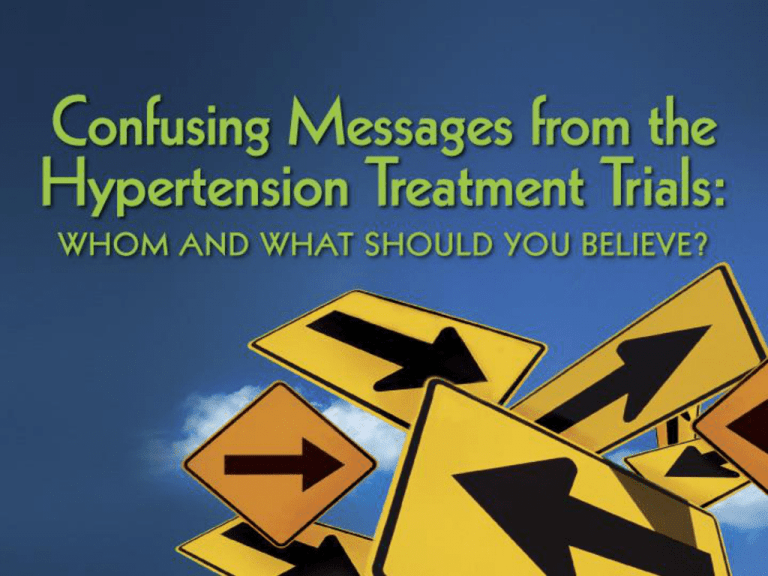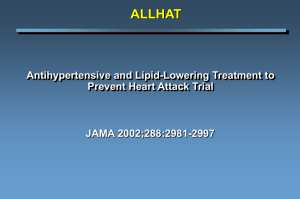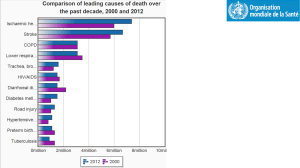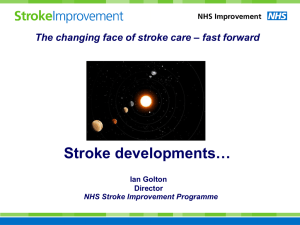
Is It the Achieved Blood Pressure
or Specific Medications
that Make a Difference in Outcome,
or Is the Question Moot?
William C. Cushman, MD
Professor, Preventive Medicine and Medicine
University of Tennessee College of Medicine
Chief, Preventive Medicine
VA Medical Center, Memphis, Tennessee
3
DISCLOSURE OF RELATIONSHIPS
for William C. Cushman, MD, Over the Past 12 Months
Type of Relationship
Name of Company
Grant/Research Support
Astra-Zeneca, Abbott, Novartis,
Aventis, King Pharmaceuticals
Consultant
Sanofi-Aventis, Bristol-Myers Squibb,
Novartis, Pfizer, Sankyo, Forest,
Myogen
Speakers Bureau
none
Major Stock Shareholder
none
Other Support,
Tangible or Intangible
none
VA Cooperative Morbidity Trial
in Hypertension
75
Placebo
55
CV Events (%)
60
45
Active
39
96% RR
67% RR
Stopped after
3.3 yrs
30
15
18
Stopped after
1.5 years
1.4
0
115-129
90-114
(N = 143)
(N = 380)
Entry Diastolic BP, mm Hg
Blood pressure (BP) goal: DBP <90 mm Hg.
Therapy: HCTZ + reserpine + hydralazine.
NNT = 2.7 for both.
RR = risk reduction.
JAMA. 1967;202(11):1028-1034.
JAMA. 1970;213(7): 1143-1152.
Blood Pressure Levels* and Event Reduction
in Selected Clinical Trials
Trial
Baseline BP
Treated BP
Active
Event ↓
Control
HDFP
159/101
131/86
142/91
17% - mortality
SHEP
170/77
144/68
155/73
36% - stroke
Syst-EUR
174/86
151/79
161/84
42% - stroke
PROGRESS
147/86
134/78
143/82
28% - stroke
PROGRESS - HTN
159/93
138/81
146/84
32% - stroke
HOPE
139/79
135/76
138/78
22% - CVD
* mm Hg
Hypertension Detection and Follow-up Program (HDFP). JAMA. 1979;242(23):2562-2571. Systolic
Hypertension in the Elderly Program (SHEP) Cooperative Research Group. JAMA. 1991;265(24):3255-3264.
Systolic Hypertension in Europe Trial (Syst-EUR) Investigators. Lancet. 1997;350:757-764. Perindopril
Protection Against Recurrent Stroke Study (PROGRESS) Collaborative Group. Lancet.
2001;358(9287):1033-1041. Heart Outcomes Prevention Valuation Study (HOPE) Investigators. N Engl J
Med. 2000;342:145-153.
Network Meta-analysis
of Antihypertensive Drugs
Low-dose Diuretics versus Placebo
Outcome
RR
95% CI
P
CHD
0.79
0.69-0.92
0.002
Heart failure
0.51
0.42-0.62
<0.001
Stroke
0.71
0.63-0.81
<0.001
CVD events
0.76
0.69-0.83
<0.001
CVD mortality
0.81
0.73-0.92
0.001
Total mortality
0.90
0.84-0.96
0.002
0.40
0.65
0.90
Low-dose diuretics better
1.15
1.40
Low-dose diuretics worse
Psaty BM et al. JAMA. 2003;289:2534-2544.
BP Reduction and Major Cardiovascular Outcomes
1.50
Stroke
CVD
Heart Failure
CHD
1.25
1.00
0.75
0.50
0.25
1.50
1.25
1.00
0.75
0.50
0.25
-10
-8
-6
-4
-2
0
2
4
-10
-8
-6
-4
-2
0
2
4
Systolic blood pressure difference between randomised groups (mmHg).
Blood Pressure Lowering Treatment Trialists’ Collaboration. Lancet. 2003;362:1527-1535.
MRC in the Elderly:
Mean Level of BP by Sex and Treatment
Men
Mean diastolic BP
Mean systolic BP
190
Women
190
180
180
170
170
160
160
150
150
140
140
Placebo
b-blocker
Diuretic
95
90
95
90
85
85
80
80
75
75
70
70
g
try
in
en
ad
e
r
Dr
3
6
9
12
24
36
Interval from entry (months)
48
60
g
try
in
en
ad
e
r
Dr
3
6
9
12
24
36
48
60
Interval from entry (months)
MRC Working Party. BMJ. 1992;304:405-412.
MRC in the Elderly:
Effects of Treatment on Stroke Incidence
Treatment vs Placebo,
P = 0.04 (RR = 25%)
Cumulative % events
8
Diuretic vs β-blocker,
P = 0.33
7
6
5
Placebo
b-blocker
Diuretic
4
3
2
1
N = 4396
0
0
1
2
3
4
5
6
7
Interval from entry (years)
MRC Working Party. BMJ. 1992;304:405-412.
Cumulative % events
MRC in the Elderly:
Effects of Treatment on Coronary Events
10
Treatment vs Placebo,
P = 0.08 (RR = 19%)
8
Diuretic vs β-blocker,
P = 0.006
6
Placebo
b-blocker
Diuretic
4
2
N = 4396
0
0
1
2
3
4
5
6
7
Interval from entry (years)
MRC Working Party. BMJ. 1992;304:405-412.
MRC in the Elderly: Effects of
Treatment on Cardiovascular Events
CVD Events/1,000 pt-yrs
30
25.2
25
Diuretic vs β-blocker,
P = 0.007
24.6
20
17.4
15
10
5
0
Placebo
Atenolol
HCTZ/amiloride
Randomized Group
N = 4396
MRC Working Party. BMJ. 1992;304:405-412.
12
ALLHAT
Hypertension Trial
42,418 high-risk
hypertensive patients
90% previously treated
10% untreated
STEP 1 AGENTS (Double-blind)
Chlorthalidone
Amlodipine
Lisinopril
Doxazosin
12.5-25 mg
2.5-10 mg
10-40 mg
1-8 mg
N=9,054
N=9,061
N=15,255
N=9,048
STEP 2 AND 3 AGENTS
Atenolol
28.0%
Clonidine
10.6%
Reserpine
4.3%
Hydralazine
10.9%
13
ALLHAT: Doxazosin vs Chlorthalidone
SBP Results by Treatment Group
150
Chlorthalidone
Doxazosin
mm Hg
145
BL
6M
1Y
2Y
4Y
DOX
146.3
141.1
140.1
138.2
137.4
CTD
146.2
138.2
136.9
135.9
135.3
140
135
130
0
6
12
18
24
Months
30
36
42
48
There were no
differences in DBP.
ALLHAT Collaborative Research group. JAMA. 2000;283:1967-1975
Final Outcomes Results
ALLHAT
Doxazosin vs. Chlorthalidone
Relative Risk and 95% Confidence Intervals
CHD
1.03 (0.92 - 1.15)
All-Cause Mortality
1.03 (0.94 - 1.13)
Combined CHD
1.07 (0.99 - 1.16)
Stroke, p=0.001
1.26 (1.10 - 1.46)
Heart Failure, p<0.001
1.80 (1.61 - 2.02)
Combined CVD, p<0.001
1.20 (1.13 - 1.27)
0.50
Favors Doxazosin
1
2
3
Favors Chlorthalidone
ALLHAT Collaborative Research group. Hypertension. 2003;42:239-246.
15
Estimated BP Effect on RR Differences
• A 3 mm Hg higher SBP in the doxazosin
group could explain a 10% to 20% difference
in HF* but not an 80% difference in risk.
• 3 mm Hg could account for 15-20% increase
in stroke risk**—26% was observed.
• Thus, the observed BP differential may
explain much of the stroke, but not HF,
differences observed between chlorthalidone
and doxazosin in ALLHAT.
* Based on SHEP and Syst-EUR.
** Based on meta-analysis of all diuretic/b-blocker trials.
ALLHAT Collaborative Research group. JAMA. 2000; 283:1967-1975; Hypertension. 2003;42:239-246.
16
ALLHAT
Doxazosin vs Chlorthalidone:
Heart Failure, Adjusting* for BP
ALL HF
RR (95% CI)
Hosp./Fatal HF
RR (95% CI)
As randomized
2.04†
(1.79, 2.32)
1.83†
(1.58, 2.13)
Adjusted
2.00†
(1.72, 2.32)
1.80†
(1.51, 2.13)
*Adjusted for BL SBP/DBP and FU SBP/DBP
†
P < 0.001
Davis BR et al. Ann Intern Med. 2002;137:313-320.
Doxazosin vs Chlorthalidone:
Heart Failure Beyond 1 Yr
by BP Level at 1 Yr
17
Chlorthalidone
Rate /100pt-yrs
2
RR=1.17
Doxazosin
RR=1.63*
1.5
1
0.5
0
≥ 140/90 mm Hg
<140/90 mm Hg
RR = hazard ratio (doxazosin/chlorthalidone)
*CI = 1.20-2.05
Davis BR et al. Ann Intern Med. 2002;137:313-320.
BP Levels by Treatment Group
for Chlorthalidone, Amlodipine, and Lisinopril
18
Chlorthalidone
Amlodipine
Lisinopril
90
150
SBP, mm Hg
145
DBP, mm Hg
~2 mm Hg lower in
chlorthalidone vs
lisinopril group
140
80
135
75
130
70
0
1
2
3
Years
4
5
6
~1 mm Hg lower in
amlodipine group
85
0
1
2
3
Years
4
5
6
BP <140/90 mm Hg at 5 yrs:
Chlorthalidone 68%
Amlodipine 66%
Lisinopril 61%
ALLHAT Collaborative Research group JAMA. 2002;288:2981-2997.
19
ALLHAT
Major Outcomes
Relative Risks and 95% Confidence Intervals
Amlodipine/Chlorthalidone
Lisinopril/Chlorthalidone
CHD
0.98 (0.90-1.07)
0.99 (0.91-1.08)
All-Cause Mortality
0.96 (0.89-1.02)
1.00 (0.94-1.08)
Stroke
0.93 (0.82-1.06)
1.15 (1.02-1.30)
Combined CVD
1.04 (0.99-1.09)
1.10 (1.05-1.16)
Heart Failure
1.38 (1.25-1.52)
1.19 (1.07-1.31)
ESRD
1.12 (0.89-1.40)
1.11 (0.88-1.38)
0.50
Favors
Amlodipine
1
2
Favors
Chlorthalidone
0.50
Favors
Lisinopril
1
2
Favors
Chlorthalidone
ALLHAT Collaborative Research group JAMA. 2002; 288: 2981-2997.
ALLHAT
Only Subgroup Differences:
Lisinopril vs Chlorthalidone in
Blacks/Non-Blacks for CVD & Stroke
Non-Blacks
Blacks
CHD
1.10 (0.94 - 1.28)
0.94 (0.85 - 1.05)
All-Cause Mortality
1.06 (0.95 - 1.18)
0.97 (0.89 - 1.06)
Combined CVD*
1.19 (1.09 - 1.30)
1.06 (1.00 - 1.13)
Stroke*
1.40 (1.17 - 1.68)
1.00 (0.85 - 1.17)
Heart Failure
1.32 (1.11 - 1.58)
1.15 (1.01 - 1.30)
ESRD
1.29 (0.94 - 1.75)
0.93 (0.67 - 1.30)
0.50
Favors
Lisinopril
1
2
Favors
Chlorthalidone
* Significant interaction
0.50
Favors
Lisinopril
1
2
Favors
Chlorthalidone
Wright JT et al. JAMA. 2005; 293: 1595-1608.
21
Cumulative Event Rates for Heart Failure
by ALLHAT Treatment Group for Year 1
ALLHAT
Cumulative HF Rate
.02
RR (95% CI)
P value
A/C
2.32 (1.83-2.94)
<.001
L/C
2.22 (1.75-2.82)
<.001
Amlodipine
Lisinopril
.01
Chlorthalidone
0
0
.5
1
Years to HF
Davis, et al. Circulation. 2006;113:2201-2210.
22
Heart Failure Beyond 1 Yr by BP Level at 1 Yr in
Chlorthalidone, Amlodipine and Lisinopril Groups
≥140/90 mm Hg
5 Yr Event Rate/100
8
RR U/C
= 1.41*
<140/90 mm Hg
RR U/C
= 1.27**
RR U/C
= 1.29†
6
4
2
0
Chlorthalidone
Amlodipine
RR U/C = hazard ratio uncontrolled/controlled
*p<0.001, **p=0.017, †p=0.023
Lisinopril
ALLHAT. Unpublished data. 2006.
23
Amlodipine and Lisinopril vs Chlorthalidone:
Heart Failure Beyond 1 Yr by BP Level at 1 Yr
Chlorthalidone
Lisinopril
RR A/C
= 1.16
8
5 Yr Event Rate/100
Amlodipine
RR L/C
= 0.92
6
RR A/C
= 1.30*
RR L/C
= 1.01
4
2
0
≥ 140/90 mm Hg
RR = hazard ratio
*p<0.01
<140/90 mm Hg
ALLHAT. Unpublished data. 2006.
24
ALLHAT
BP Differences:
Lisinopril versus Chlorthalidone
Mean follow-up SBP for L versus C
2
mm Hg higher—all participants
4
mm Hg higher—Black participants
Adjustment for follow-up SBP/DBP as timedependent covariates in a Cox regression model
slightly reduced the relative risks, but they
remained statistically significant.
Stroke
(1.15 → 1.12) & HF (1.20 → 1.17), overall
Stroke
(1.40 → 1.35) & HF (1.32 → 1.26), for
Blacks
ALLHAT Collaborative Research group JAMA. 2002; 288: 2981-2997.
25
ALLHAT
BP Differences:
Lisinopril versus Chlorthalidone
(continued)
Prospective observational studies predict that 2
mm Hg difference → 9% higher stroke mortality
and 6% higher HF mortality, versus 15 and 19%
higher risk (fatal + nonfatal events) observed in
ALLHAT.
Based on same data, 4 mm Hg difference in
blacks would predict 19% higher stroke mortality
and 14% higher HF mortality, versus 40% and
32% higher risk (fatal + nonfatal events)
observed in ALLHAT.
ALLHAT Collaborative Research group JAMA. 2002; 288: 2981-2997.
26
Cardiovascular Events and Total Mortality
in SCOPE and LIFE
0.5
Major CV event
SCOPE
LIFE
CV death
SCOPE
LIFE
Fatal/non-fatal stroke SCOPE
LIFE
Fatal/non-fatal MI
SCOPE
LIFE
Total Mortality
SCOPE
LIFE
Relative risk
1.0
2.0
There was little BP
difference in LIFE and
3.2/1.6 mm Hg lower BP
in the candesartan
group in SCOPE, but
event RRs were similar
Favors AT1 blockade
Favors control
LIFE (n=9193): losartan vs atenolol
SCOPE (n=4964): candesartan vs placebo
Lithel H et al. J Hypertens. 2003;21:875–886.
Initial Combinations of Medications
for Management of Hypertension*
Diuretics
ACE inhibitors
or
ARBs
Calcium
antagonists
* Compelling indications may modify this.
Achieved Blood Pressure
Versus Specific Medications: Effects on Outcomes
Drugs with very different physiologic effects may
logically have different effects on organs/events
independent of BP.
In ALLHAT and other trials, adjustment of clinical
event rates based on observational analyses of BP
differences are limited by variability of BP
measurement and absence of non-clinic BPs.
Achieved Blood Pressure
Versus Specific Medications: Effects on Outcomes
(continued)
Outcome differences in many studies are not fully
explained by clinically detectable BP differences.
BP control IS of paramount importance, but it
DOES also matter which drugs we use.









